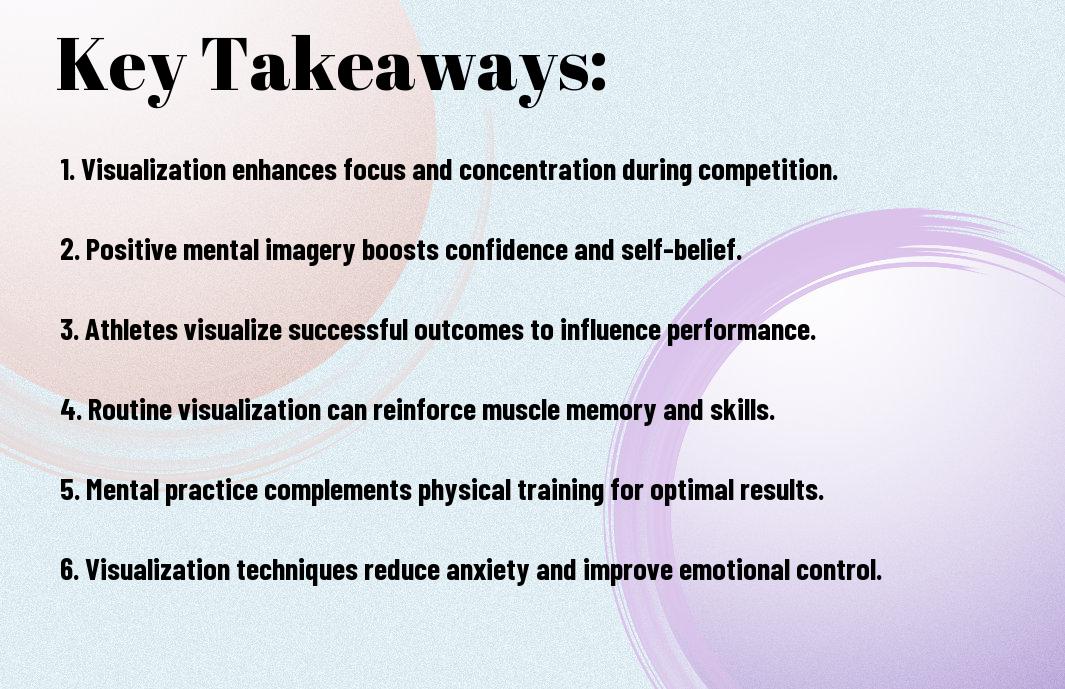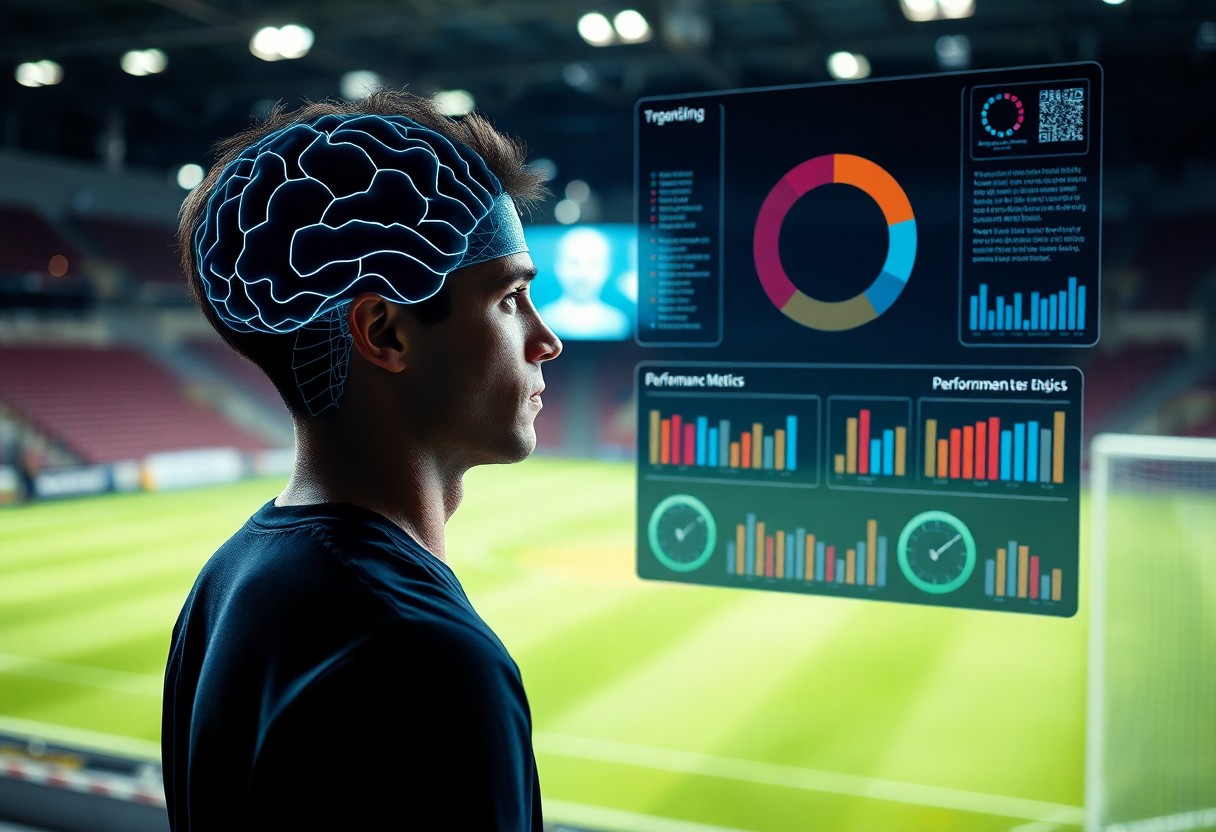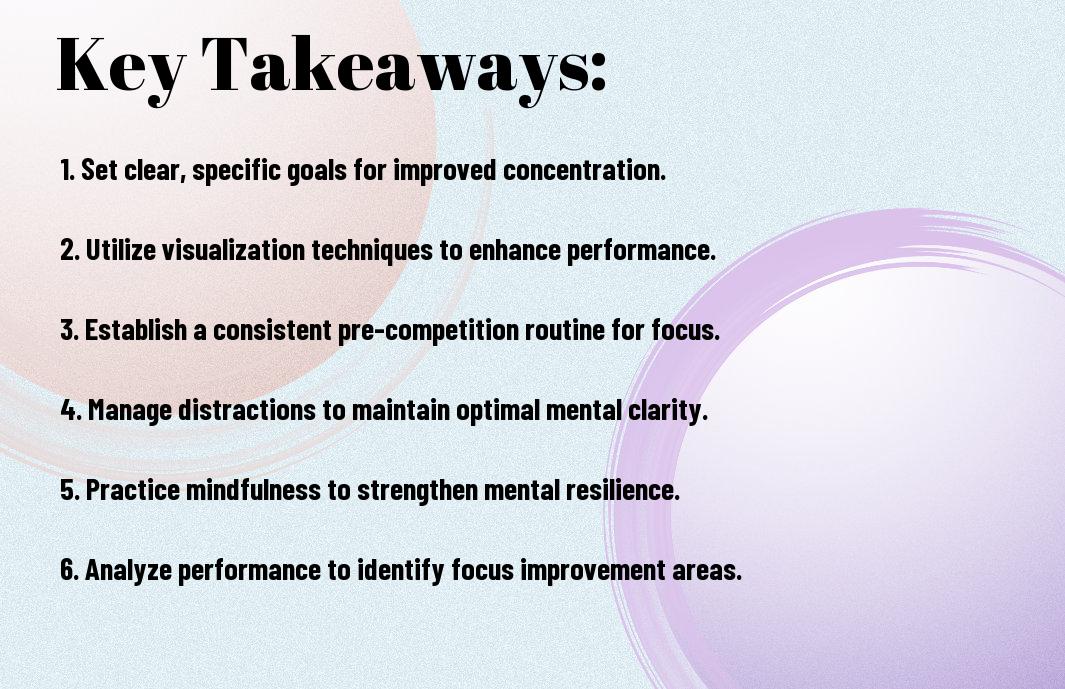Just as athletes hone their physical skills, the mental aspect of sports is equally imperative to your performance. Visualization techniques allow you to mentally rehearse your movements and strategies, improving focus and confidence during competition. By vividly imagining yourself succeeding, you can create neural patterns that enhance your physical execution. This blog post will explore effective visualization strategies that you can incorporate into your training routine to elevate your sports success to new heights.
Key Takeaways:
- Enhances Performance: Visualization can significantly improve athletic performance by allowing athletes to mentally rehearse their actions and strategies.
- Builds Confidence: Regular visualization helps athletes to cultivate a strong sense of confidence, reducing anxiety during high-pressure situations.
- Focus and Concentration: Visualization techniques aid in sharpening focus and concentration, enabling athletes to tune out distractions during competitions.
- Motivation Booster: Imagining success can serve as a powerful motivator, encouraging athletes to push through challenges and setbacks.
- Injury Recovery: Visualization can be beneficial in rehabilitation, helping athletes to mentally engage with their sport and maintain a connection to their physical performance.
Understanding Visualization in Sports
To achieve peak performance in sports, understanding the role of visualization is crucial. This mental technique involves creating mental images or scenarios to enhance your skills and boost confidence. By incorporating visualization into your training routine, you can mentally rehearse performances, solidifying strategies that will lead to success on the field or court.
Definition and Importance
Along with physical training, visualization serves as a powerful tool to optimize your mental preparedness for competition. It encompasses imagining successful outcomes, refining techniques, and developing focus, allowing you to better handle pressure and enhance overall performance.
Psychological Mechanisms
Sports visualization taps into various psychological mechanisms that enhance your performance. By engaging in mental imagery, you can activate neural pathways similar to those used during actual physical performance. This technique allows you to practice skills and problem-solving, bridging the gap between mental preparation and physical execution.
Further, visualization promotes relaxation and reduces anxiety by familiarizing you with competitive situations. This mental rehearsal helps you develop muscle memory, making it easier to execute skills during high-pressure scenarios. The combination of these psychological effects enables you to build confidence, improve focus, and ultimately enhance your ability to perform under stress, leading to improved outcomes in your athletic endeavors.

The Impact of Visualization on Performance
If you engage in visualization techniques, you can significantly improve your performance in various sports. By picturing your successful execution of skills or strategies, you create mental pathways that enhance your physical execution. This mental practice helps to reinforce muscle memory and allows you to perform more effectively under pressure. Visualization not only prepares you for competition but also fosters a winning mindset, making it an crucial tool for athletes seeking to maximize their potential.
Enhancing Focus and Concentration
Between the distractions of competition and the noise of the crowd, visualization helps you hone your focus and concentration. By visually rehearsing your routines or techniques, you block out external disturbances and direct your mental energy towards your performance. This heightened concentration allows you to be more present in the moment, improving your reaction times and decision-making skills when it counts the most.
Building Confidence and Reducing Anxiety
On your journey as an athlete, visualization can play a key role in building your confidence and reducing anxiety. By picturing successful performances and positive outcomes, you can shift your mindset from self-doubt to self-assurance. This mental rehearsal not only prepares you for challenges but also instills a sense of control over your performance, allowing you to approach competitions with a confident demeanor.
This powerful mental practice cultivates a strong belief in your abilities, which is crucial for peak performance. By regularly visualizing your successes, you train your mind to expect favorable outcomes. Over time, this reinforcement helps minimize feelings of pressure and anxiety, enabling you to compete with more ease and assurance. Ultimately, as you build confidence through visualization, you’ll find yourself better equipped to handle high-stakes situations and exceed your own expectations.
Techniques for Effective Visualization
Not all visualization techniques are created equal; for them to be effective, you must find the method that resonates with you. Exploring diverse approaches, such as guided imagery and mental rehearsal, can significantly enhance your performance. When you practice visualization consistently and integrate it into your training routine, you will discover its true potential in fostering success in your sport.
Guided Imagery
On your journey to mastering visualization, guided imagery serves as a powerful tool. This technique involves listening to a trained instructor or a recorded session that leads you through vivid mental images related to your sport. By engaging your senses and emotions, you not only envision the desired outcomes but also create a strong mental connection that can improve your focus and performance. As you practice, you’ll notice these mental images translating into real-life success.
Mental Rehearsal
One of the most effective visualization techniques is mental rehearsal, where you mentally simulate your performance before executing it. By vividly picturing yourself successfully executing your skills, you enhance your muscle memory and increase your confidence. This process allows you to anticipate challenges and develop strategies to overcome them, making it a vital part of your preparation.
Plus, mental rehearsal goes beyond simply envisioning a successful performance; it allows you to analyze and refine your techniques. You can envision various scenarios, challenging yourself to adapt and strategize. This proactive approach not only boosts your confidence but also enables you to approach competitions with a clear and composed mindset. Incorporating mental rehearsal into your training routine can help sculpt your skills, leading to peak performance when it matters most.

Visualization Practices in Various Sports
For athletes at all levels, visualization serves as a powerful tool to enhance performance. Different sports have unique visualization practices tailored to their specific demands. Whether it’s a gymnast perfecting a routine or a sprinter envisioning their race, the ability to mentally rehearse can significantly boost confidence and skill execution. By integrating visualization into your training regimen, you can improve focus, reduce anxiety, and enhance your overall athletic performance.
Individual Sports
Above all, individual athletes often rely on visualization to hone their techniques and build self-confidence. Sports like tennis, swimming, and track rely heavily on mental imagery to rehearse movements and strategies. By vividly imagining the execution of techniques or race scenarios, you can create neural pathways that enhance muscle memory and improve performance under pressure.
Team Sports
Before competing in team sports, visualization becomes a collective exercise that strengthens team dynamics and communication. Each member can visualize their specific role in a match or game scenario, creating a shared understanding of strategies and movements. This practice not only paves the way for smoother execution during the actual game but also fosters a sense of unity and confidence among teammates.
And as you engage in visualization for team sports, consider incorporating scenario-based imagery that reflects various game situations. Picture successful plays, effective teamwork, and strategies that capitalize on each member’s strengths. This mental rehearsal keeps you prepared for real-time challenges and contributes to a more seamless performance as a cohesive unit. You might find that visualizing both victory and overcoming obstacles as a team can significantly elevate your collective confidence and effectiveness on the field or court.
Case Studies and Success Stories
Your understanding of visualization’s impact on sports success can be enhanced by examining notable case studies highlighting its effectiveness:
- Michael Phelps: Utilized visualization techniques for 200+ hours leading to 23 Olympic gold medals.
- Jack Nicklaus: Credited visualization for 80 PGA Tour victories, often envisioning each shot before execution.
- Jim Furance: Achieved a 60% improvement in free-throw percentage after implementing mental imagery practice.
- Kristin Armstrong: Adopted mental visualization training to win three consecutive Olympic gold medals in cycling.
- Wayne Gretzky: Used visualization to strategize plays, contributing to his 2,857 career points in the NHL.
Athletes Who Utilize Visualization
Below are examples of top athletes who employ visualization techniques as part of their training routines:
- LeBron James: Visualizes game plays pre-match.
- Serena Williams: Envisions key plays and match scenarios.
- Eli Manning: Practices mental rehearsals of game strategies weekly.
- Simone Biles: Regularly uses visualization before competitions.
- Usain Bolt: Imagines winning and maintaining technique during sprints.
Statistical Evidence of Visualization’s Effectiveness
One compelling example comes from a study showing athletes who practice visualization techniques achieved a 23% increase in overall performance metrics compared to their pre-visualization benchmarks.
Also, various psychological studies indicate athletes who integrate visualization report a 45% higher confidence level during competitions, suggesting that the mental rehearsal process can lead to better physical execution. Additional research shows that 97% of elite athletes claim they regularly use visualization, demonstrating its prevalence and perceived value within the sports community. This evidence alludes to a solid correlation between mental imagery and improved performance outcomes in competitive settings.
Challenges and Misconceptions
After recognizing the benefits of visualization in sports, it’s important to address the challenges and misconceptions surrounding this powerful mental tool. Many athletes struggle to incorporate visualization into their routines, often due to a lack of understanding or skepticism about its effectiveness. Additionally, the pressures of competition and rigorous training schedules can make it difficult for you to dedicate time to mental practice. By identifying these barriers, you can begin to navigate and overcome them, enhancing your overall performance.
Common Misunderstandings
Any discussion about visualization often includes misunderstandings regarding its purpose and implementation. Some athletes believe that visualization alone will lead to success, overlooking the need for physical training and skill development. Others think that visualization is a passive exercise, not realizing it requires active engagement and focus to be effective. Clarifying these misconceptions can empower you to utilize visualization more effectively.
Overcoming Barriers to Visualization
Before you can fully embrace visualization, it’s important to confront any barriers that may hinder your practice. Time constraints, doubt in your mental capabilities, or a lack of guidance can all be obstacles to effective visualization. Acknowledging these challenges is the first step; from there, you can develop a consistent routine and seek support from coaches or peers.
In fact, overcoming barriers to visualization is often about creating a structured approach that fits your lifestyle. You might start by setting aside just a few minutes each day for mental exercises, gradually increasing the duration as you become more comfortable. Additionally, employing techniques like guided imagery or focusing on specific goals can help deepen your practice. By actively addressing these challenges, you can unlock the potential of visualization and enhance your sports performance.
Conclusion
To wrap up, incorporating visualization techniques into your training can significantly enhance your performance and overall success in sports. By vividly imagining your goals and rehearsing your actions mentally, you not only boost your confidence but also prepare your mind and body for real-life situations. As you practice these techniques regularly, you’ll find that they enable you to maintain focus and resilience in high-pressure environments. Embrace visualization as a valuable tool in your arsenal, and watch how it transforms your athletic journey.
Q: How does visualization help athletes improve their performance?
A: Visualization can enhance an athlete’s performance by allowing them to mentally rehearse their actions before executing them in real-life situations. This mental practice can create a strong neural connection in the brain, making physical execution feel more familiar and achievable. By regularly visualizing successful performances, athletes can build confidence, reduce anxiety, and enhance focus during competition. It serves as a valuable tool for refining skills and strategies, enabling athletes to approach their sport with a clear mindset and improved mental preparedness.
Q: What techniques can athletes use for effective visualization?
A: Effective visualization techniques often involve creating a detailed mental image of oneself successfully performing specific skills or strategies relevant to their sport. Athletes should find a quiet space, close their eyes, and engage all their senses in the visualization process. They can visualize the sights, sounds, and feelings associated with their performance. Techniques like guided imagery, where an athlete listens to a script that describes a successful performance, or creating a vision board with images of their goals, can also enhance the effectiveness of visualization. Setting aside dedicated time daily for these practices can help reinforce the mental imagery and make it a natural part of their preparation.
Q: Can visualization be used to overcome fear or anxiety in athletes?
A: Yes, visualization can be an effective strategy for addressing fear and anxiety in athletes. By visualizing themselves successfully overcoming challenges or performing under pressure, athletes can gradually desensitize themselves to their fears. This process helps them envision their responses and actions in a controlled environment, reducing the emotional impact during actual performance situations. Additionally, incorporating relaxation techniques alongside visualization can help athletes manage their anxiety levels, leading to greater composure and focus when competing. Frequent practice can contribute to developing a positive mindset, allowing athletes to view challenges as opportunities for growth.


